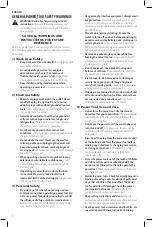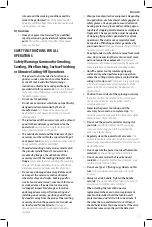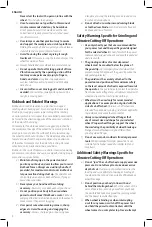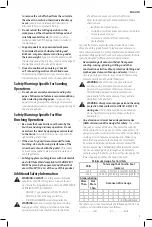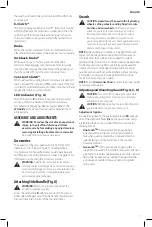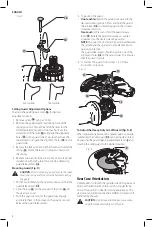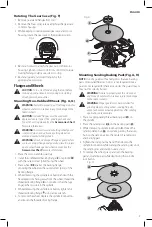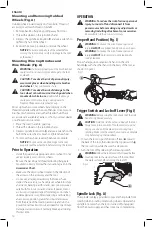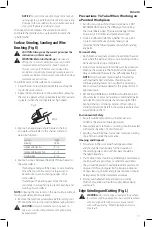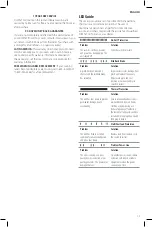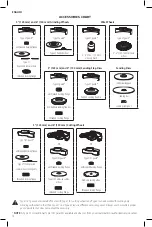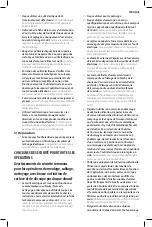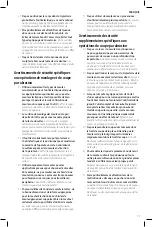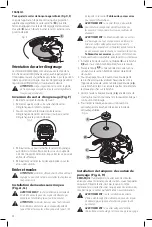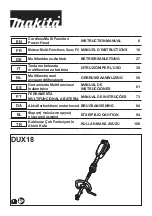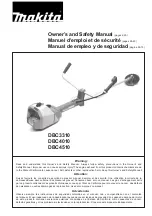
English
9
Rotating The Gear Case (Fig. F)
1. Remove guard and flanges from tool.
2. Remove the four corner screws attaching the gear case
to motor housing.
3. While keeping contact between gear case and motor
housing, rotate the gear case to the desired position.
90˚
90˚
Fig. F
4. Re-install screws to attach the gear case to the motor
housing. Tighten screws to 18 in./lbs. (2.03 Nm) torque.
Overtightening could cause screws to strip.
5. Re-install guard and correct flanges for the
appropriate accessories.
Flanges and Wheels
CAUTION:
Turn unit off and unplug the tool before
making any adjustments or removing or installing
attachments or accessories.
Mounting Non-Hubbed Wheels (Fig. A, G)
WARNING:
Failure to properly seat the flanges and/or
wheel could result in serious injury (or damage to the
tool or wheel).
CAUTION:
Included flanges must be used with
depressed center Type 27/42 grinding wheels and
Type 1/41 cutting wheels. See the
Accessories Chart
for more information.
WARNING:
A closed, two-sided cutting wheel guard
is required when using abrasive cutting wheels or
diamond coated cutting wheels.
WARNING:
Use of a damaged flange or guard or fail-
ure to use proper flange and guard can re sult in injury
due to wheel breakage and wheel contact. See the
Accessories Chart
for more information.
1. Place the tool on a table, guard up.
2. Install the unthreaded backing flange
2
on spindle
19
with the raised center (pilot) facing the wheel.
3. Place wheel
20
against the backing flange,
centering the wheel on the raised center (pilot) of the
backing flange.
4. While depressing the spindle lock button and with the
hex depressions facing away from the wheel, thread the
threaded locking flange
3
on spindle so that the lugs
engage the two slots in the spindle.
5. While depressing the spindle lock button, tighten the
threaded locking flange
3
using a Hex wrench.
6. To remove the wheel, depress the spindle lock button
and loosen the threaded locking flange.
Fig. G
2
3
19
20
Mounting Sanding Backing Pads (Fig. A, H)
nOTE:
Use of a guard with sanding discs that use backing
pads, often called fiber resin discs, is not required. Since a
guard is not required for these accessories, the guard may or
may not fit correctly if used.
WARNING:
Failure to properly seat the clamp nut
and/or pad could result in serious injury (or damage
to the tool or wheel).
WARNING:
Proper guard must be reinstalled for
grinding wheel, cutting wheel, sanding flap disc,
wire brush or wire wheel applications after sanding
applications are complete.
1. Place or appropriately thread backing pad
21
on
the spindle.
2. Place the sanding disc
22
on the backing pad
21
.
3. While depressing spindle lock button
1
, thread the
sanding clamp nut
23
on spindle, piloting the raised
hub on the clamp nut into the center of san ding disc
and backing pad.
4. Tighten the clamp nut by hand. Then depress the
spindle lock button while turning the sanding disc until
the sanding disc and clamp nut are snug.
5. To remove the wheel, grasp and turn the backing
pad and sanding pad while depressing the spindle
lock button.
Fig. H
23
22
21




